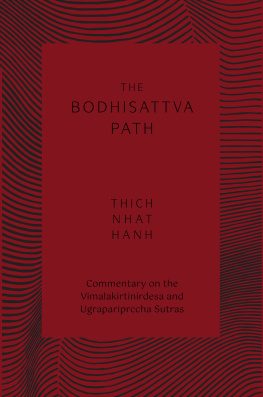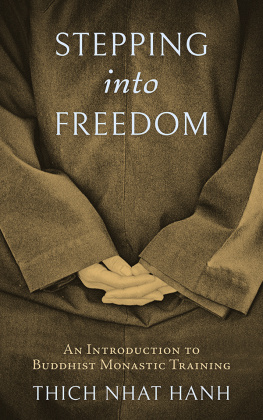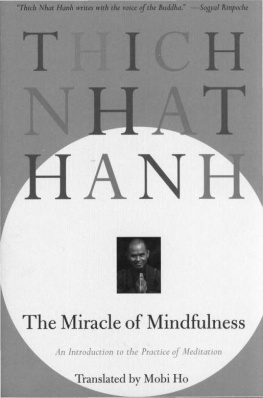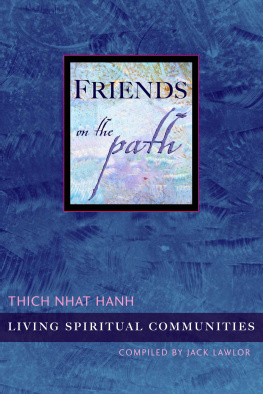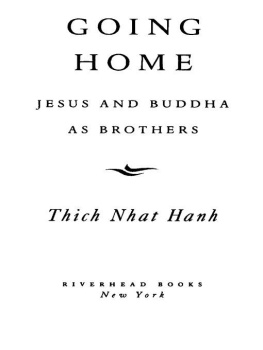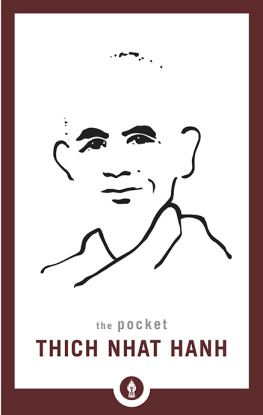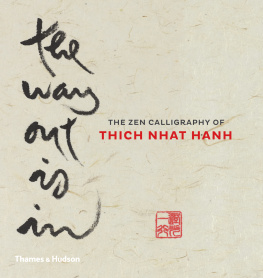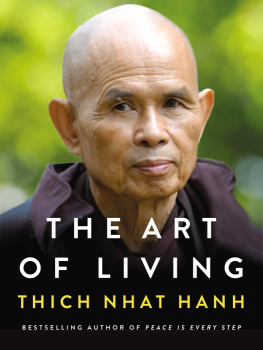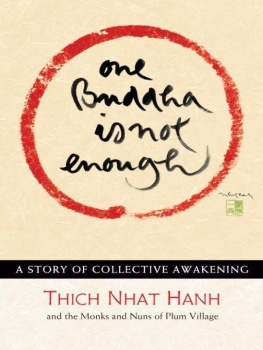PATH OF COMPASSION

Contents
Twenty years ago, Thich Nhat Hanh wrote a book called Old Path White Clouds that recounted the life of the historical Buddha. The book describes the Buddha as a human being like all of us, capable of human emotions and concerns. Like the Buddha, we all have Buddha nature and are capable of living as bodhisattvas, people who have dedicated their lives to the welfare of all beings.
As Thich Nhat Hanh wrote in that original edition:
In writing this bookI have avoided including the many miracles that are often used in the sutras to embellish the Buddhas life. The Buddha himself advised his disciples not to waste time and energy on acquiring or practicing supernatural powers. I have, however, included many of the difficulties the Buddha encountered during his life from both the larger society and his own disciples. If the Buddha appears in this book as a human being close to us, it is partly thanks to recounting such difficulties.
Since the first publication of Old Path White Clouds, people have requested a condensed edition of the book, focused on the Buddhas life and travels, that can introduce people to the practice of mindfulness. We created this book in the hopes that you can, indeed, carry it with you as you walk in the footsteps of the Buddha.
Rachel Neumann, Parallax Press

As King Suddhodhana hurried in to see his wife and newborn son, his joy was boundless.
When he was nine years old, Siddhartha was told about the dream his mother had before giving birth to him. A magnificent white elephant with six tusks descended from the heavens surrounded by a chorus of beatific praises. The elephant approached his mother, its skin as white as mountain snow. It held a brilliant pink lotus flower in its trunk, and placed the flower within the queens body. Then the elephant, too, entered her effortlessly, and all at once she was filled with deep ease and joy. She had the feeling she would never again know any suffering, worry, or pain, and she awoke uplifted by a sensation of pure bliss. When she got up from her bed, the ethereal music from the dream still echoed in her ears. She told her husband, the king, of the dream, and he, too, marveled at it. That morning, the king summoned all the holy men in the capital to come and divine the meaning of the queens dream.
After listening intently to the dreams content, they responded, Your majesty, the queen will give birth to a son who will be a great leader. He is destined to become either a mighty emperor who rules throughout the four directions, or a great Teacher who will show the Way of Truth to all beings in Heaven and Earth. Our land, your majesty, has long awaited the appearance of such a Great One.
King Suddhodana beamed. After consulting the queen, he ordered that provisions from the royal storehouses be distributed to the ill and unfortunate throughout the land. Thus the citizens of the kingdom of Sakya shared the king and queens joy over the news of their future son.
Siddharthas mother was named Mahamaya. A woman of great virtue, her love extended to all beingspeople, animals, and plants. It was the custom in those days for a woman to return to her parents home to give birth there. Mahamaya was from the country of Koliya, so she set out for Ramagama, the capital of Koliya. Along the way, she stopped to rest in the garden of Lumbini. The forest there was filled with flowers and singing birds. Peacocks fanned their splendid tails in the morning light. Admiring an ashok tree in full bloom, the queen walked toward it when suddenly, feeling unsteady, she grabbed a branch of the ashok tree to support her. Just a moment later, still holding the branch, Queen Mahamaya gave birth to a radiant son.
The prince was bathed in fresh water and wrapped in yellow silk by Mahamayas attendants. As there was no longer any need to return to Ramagama, the queen and the newborn prince were carried home in their four-horse carriage. When they arrived home, the prince was again bathed in warm water and placed next to his mother.
Hearing the news, King Suddhodana hurried in to see his wife and son. His joy was boundless. His eyes sparkled and he named the prince Siddhartha, which meant the one who accomplishes his aim. Everyone in the palace rejoiced and, one by one, they came to offer their congratulations to the queen. King Suddhodana wasted no time in summoning the soothsayers to tell him of Siddharthas future. After examining the babys features, they all agreed that the boy bore the marks of a great leader and would no doubt rule over a mighty kingdom that spread in all four directions.
One week later, a holy man named Asita Kaladevala paid a visit to the palace. His back was bent with age, and he needed a cane to descend the mountain where he lived. When the palace guards announced Master Asitas arrival, King Suddhodana personally came out to greet him. He ushered him in to see the baby prince. The holy man gazed at the prince for a long time without uttering a word. Then he began to weep, his trembling body supported by his cane. Streams of tears fell from his eyes.
King Suddhodana grew alarmed and asked, What is it? Do you forebode some misfortune for the child?
Master Asita wiped the tears with his hands and shook his head. Your majesty, I see no misfortune at all. I weep for myself, for I can clearly see that this child possesses true greatness. He will penetrate all the mysteries of the universe. Your majesty, your son will not be a politician. He will be a great Master of the Way. Heaven and Earth will be his home and all beings his relations. I weep because I will pass away before I have a chance to hear his voice proclaim the truths he will realize. Majesty, you and your country possess great merit to have given birth to such a one as this boy.
Asita turned to leave. The king pleaded for him to stay, but it was of no use. The old man began walking back to his mountain. Master Asitas visit sent the king into a frenzy. He did not want his son to become a monk. He wanted Siddhartha to assume his throne and extend the borders of their kingdom. The king thought, Asita is only one among hundreds, even thousands of holy men. Perhaps his prophecy is mistaken. Surely the other holy men who said Siddhartha would become a great emperor were correct. Clinging to this hope, the king was comforted.
After having attained sublime joy giving birth to Siddhartha, Queen Mahamaya died eight days later, and all the kingdom mourned her. King Suddhodana summoned the queens sister Mahapajapati, and asked her to become the new queen. Mahapajapati, also known as Gotami, agreed, and she cared for Siddhartha as if he were her own son. As the boy grew older and asked about his real mother, he understood how much Gotami had loved her sister and how she, more than anyone else in the world, could love him as much as his own mother. Under Gotamis care, Siddhartha grew strong and healthy.
One day, as Gotami watched Siddhartha play in the garden, she realized he was old enough to learn the graces of wearing gold and precious gems. She instructed her attendants to bring forth precious jewels to try on Siddhartha, but, to her surprise, none rendered Siddhartha more handsome than he already was. As Siddhartha expressed discomfort at wearing such things, Gotami ordered the jewels to be returned to their cases.
When Siddhartha reached school age, he studied literature, writing, music, and athletics with the other princes of the Sakya dynasty. Among his schoolmates were his cousins Devadatta and Kimbila, and the son of a palace dignitary, a boy named Kaludayi. Naturally intelligent, Siddhartha mastered his lessons quickly. His teacher Vishvamitra found the young Devadatta a sharp student, but never in his teaching career had he taught a student more impressive than Siddhartha.
Next page

